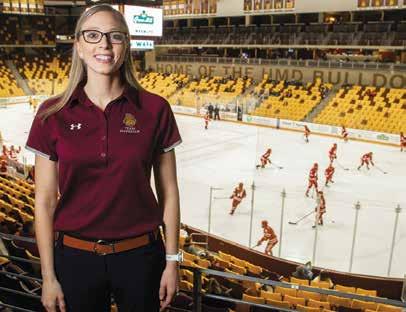
3 minute read
Use of ultrasound goes beyond expectant mothers
By Louie St. George III
Whenwe think of ultrasound, we think of babies. But the decades-old technology that uses sound waves to produce razor-sharp images has applications beyond the bellies of expectant mothers. Dr. Heather Grothe, an orthopedic sports medicine physician at Essentia Health, uses musculoskeletal (MSK) ultrasound daily, either in a clinical setting or in her role as team doctor for Minnesota Duluth women’s hockey.
Ultrasound shows what’s going on beneath the skin right now, as opposed to waiting for magnetic resonance imaging (MRI) test results. And the clarity dwarfs that of MRI.
“It’s very much a real-time diagnosis,” Dr. Grothe said. MSK ultrasound isn’t new; it’s been around for more than a decade. But its effectiveness and pervasiveness continue to expand thanks to ever-improving technology. High-resolution pictures of muscles and tendons — as well as barely perceptible nerves and ligaments — reveal sprains, strains and tears. Dynamic imaging permits more comprehensive assessments of injuries.
“I’m able to see the different layers,” Dr. Grothe said. “I can see your skin, I can see your muscles, your tendons, your nerves. I can see the outline of the bone.”
What’s more is she can “use the other extremity for comparison.” If she’s showing a patient a torn rotator cuff or ruptured Achilles tendon on the right side of the body, she then can move to the left side and say, “Here’s what it’s supposed to look like.”
“I think just seeing that helps the patient kind of connect and understand their condition,” Dr. Grothe said.
Ultrasound is safe because there is no radiation. It’s more comfortable than MRI for patients, who benefit by being able to see the images live, allowing them to better understand their injuries and take a more active role in their care. That doesn’t mean MRI is obsolete. It still has its place, especially when viewing a larger area. MRI also is able to see through bone, something ultrasound can’t do.
During UMD women’s hockey games, Dr. Grothe has a portable ultrasound machine in the training room. She can evaluate a player’s condition during the action and make an almost-immediate “play or no play” decision. The 36-yearold physician competed in volleyball and track and field — participating in pole vault and the vaunted heptathlon — at the College of Saint Benedict in St. Joseph, Minn. So she can sympathize with a player who is desperate to rejoin the fray at all costs. Been there, done that.
That desire is one part of the equation. The other is taking a step back and arriving at an objective, well-informed conclusion.
“I think the beauty of working with a great university is we have that support to always make a decision that’s right for the athlete,” Dr. Grothe said. “It’s a risk-benefit discussion, but we always have the athlete’s health at the forefront of our decision-making.
“Our coaches on both teams — men’s and women’s — respect that decision. We’ve got a great relationship.”
The versatility of MSK ultrasound includes evaluating nerve disorders, arthritis and other musculoskeletal conditions. Consequently, it’s not only for athletes. At Essentia, Dr. Grothe and her colleagues, Drs. Douglas Hoffman and Ben Nelson, form an experienced team. They collaborate with their orthopedic colleagues to help diagnose patients. They also deliver injections and perform interventional procedures such as nerve blocks via MSK ultrasound.
Medicine doesn’t run in Dr. Grothe’s family. She grew up on a dairy farm in Melrose, Minn., and first planned to get a degree in cellular molecular biology. But Dr. Grothe eventually started to miss “that human-interaction component.” Becoming a doctor was the perfect antidote. She was prepared to practice family medicine in a rural setting, but gradually was pulled toward sports medicine.
“With sports having been a large part of my life and the enjoyment I get from being active, it was just a natural draw for me,” Dr. Grothe said.
The challenge of assessing and diagnosing a patient in real-time continues to excite her. Doing so while remaining involved in athletics? Even better.
“It’s wonderful to be there and to feel like you can make a difference and keep our athletes healthy and doing what they love to do, and keeping them successful throughout that season,” Dr. Grothe said. “It’s a real privilege and honor, and I’m grateful to have that opportunity.” D
The Life You Imagined

Feeling strong, in balance and loving the body you’rein. It’swhy we’resoexcited to be the first to bring regenerative, medicine-based services to Duluth, Minnesota and the surrounding region.
By AJ Axtell
The first signs of spring are upon us — fresh skunk in the air, pet waste and garbage speckled throughout the melting snow banks, grit and mud between our toes. It makes us long for the impending green grass, spring flowers, and warm, sunny days of summer. Perhaps it also makes some of us think about how we could make things even greener this year.
To celebrate the 50th year of Earth Day on April 22, 2020, here are 10 tips and tricks that might help you spruce up your circle:
#1 – Go wrapper free!
The convenience of individually wrapped food is noteworthy. Grab and go, stick it in a pocket, stash it in the glove box, easy to throw at crabby kids, expires in 2041, tasty, yes! But, what about all that trash?
Streets, sidewalks, cup holders and pockets everywhere are riddled with the silvery leavings of yesterday’s snacks. Try taking a break. Maybe it’s just for a day. Maybe just a certain type of snack.
Choose a bulk option instead and use a reusable bag to pack your graband-gos. Where do you most often










